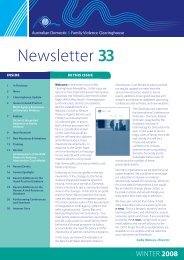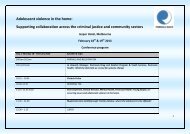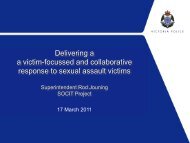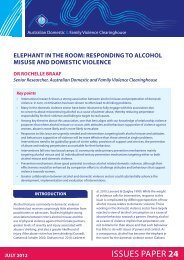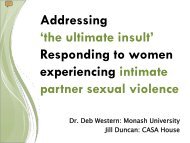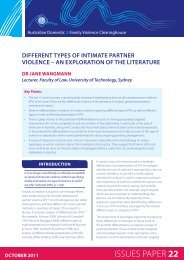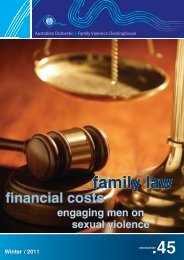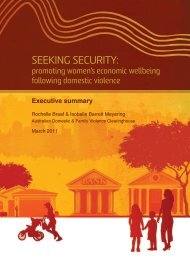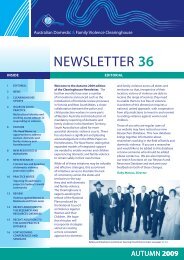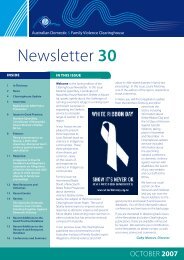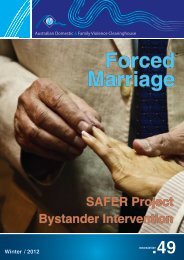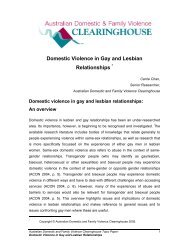Violence through our eyes - Women With Disabilities Australia
Violence through our eyes - Women With Disabilities Australia
Violence through our eyes - Women With Disabilities Australia
You also want an ePaper? Increase the reach of your titles
YUMPU automatically turns print PDFs into web optimized ePapers that Google loves.
Appendix<br />
Issues faced by women from non‐English<br />
speaking backgrounds with disability and<br />
carers who experience violence<br />
1. General issues<br />
Anglo-<strong>Australia</strong>n Service Provision<br />
Many services seem unable to accommodate linguistic and cultural diversity of consumers.<br />
The most basic mechanisms for people from NESB such as the use of interpreters or the<br />
publication of material in languages other than English are often neglected. Moreover, in<br />
many instances the ability of staff to incorporate cultural difference, diversity and in<br />
particular the nature and reality of the persons’ experience whilst delivering services is<br />
quite poor.<br />
The provision of culturally inappropriate services often results in NESB consumers having<br />
lower service usage rates in comparison to their Anglo-<strong>Australia</strong>n counterparts. As<br />
indicated in the 2009 Productivity Commission’s Report on Government Service Provision,<br />
and reflected in the experiences of MDAA’s consumers, people from NESB with disability<br />
are gravely underrepresented in accessing government funded disability services. In<br />
2006/2007, when identifying NSW service users per head of population, people from<br />
NESB with disability, equated to 0.6 service users per 1000 (under 65 years) accessing<br />
Commonwealth State/Territory Disability Agreement (CSTDA) funded community support<br />
services. This is significantly lower than the 4 service users per 1000 (under 65 years)<br />
born in an English speaking country (Productivity Commission, 2009:34). The disparity in<br />
service usage reflects the current Anglo – <strong>Australia</strong>n service provision model which<br />
inadequately caters for the cultural and linguistic needs of people from NESB.<br />
As a consequence, people from NESB, their families and carers use services when there<br />
is a high level of need or when the level of need is at crisis point.<br />
Lack of Accessible Information<br />
Access to information is often the first step towards people making meaningful<br />
choices and participating in the community. A circular from the NSW Premiers<br />
Department C1999-62 [sic] indicates the expectation that all NSW government<br />
agencies ensure that contracts with private providers and funding agreements with<br />
non-government organisations identify a budget for interpreting and translating<br />
appropriate to the service provided and the needs of the clients. Funding<br />
agencies are expected to monitor programs to ensure that language services are<br />
provided to clients who need them. Despite this the costs for language services<br />
remain mostly unbudgeted, resulting in:<br />
• a reduction in community services available to people from NESB with disability;<br />
• a lack of information;<br />
• the provision of inappropriate information; and<br />
<strong>Violence</strong> <strong>through</strong> <strong>our</strong> <strong>eyes</strong> 22



